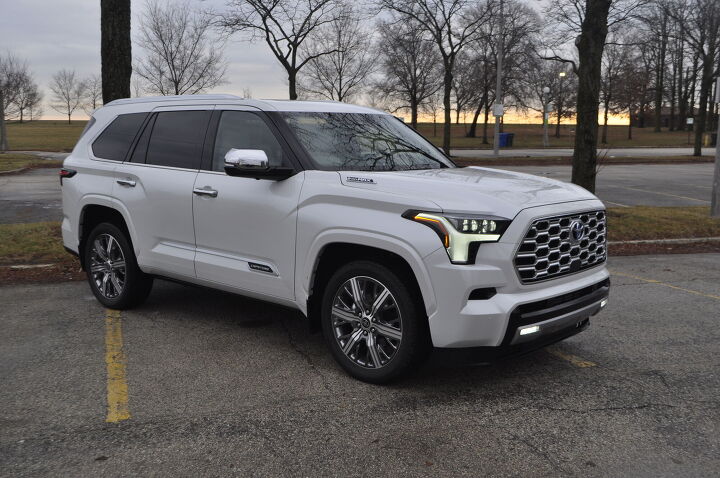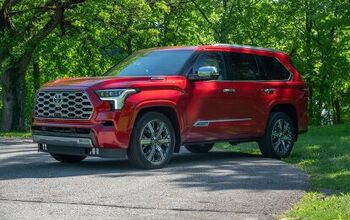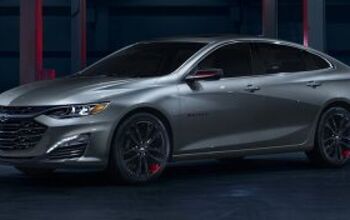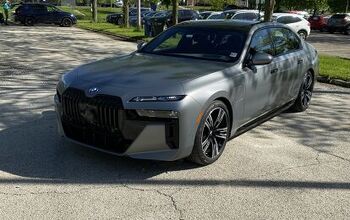2023 Toyota Sequoia Review – Comfortable Yet Cold

2023 Toyota Sequoia Platinum and Capstone Fast Facts
Large, family-hauling SUVs prioritize comfort for obvious reasons. With the 2023 Toyota Sequoia, the brand also tried to be stylish. One mission accomplished, one not so much.
As an enthusiast, the Sequoia is easy to pick on – its driving dynamics are blandly competent with little spark for the sporty-minded family man or woman. As a utility vehicle, the Sequoia works a bit better – at least as well as anything in its competitive set. As something that’s meant to appeal to the eye, well, styling is obviously subjective, but I found it to be less than pleasing to the eye.
This review will be an unusual dual-trim review – I drove two separate Sequoias within a short time of one another. They’re not different enough to justify two separate reviews. So, let’s kill two birds – trees? – with one stone. Metaphorically speaking, of course.
The Sequoia’s styling follows the blocky look of Toyota’s full-size Tundra truck. The look works better on the outside than it does on the Tundra – and better on the Sequoia’s outside than its inside. That said, it’s still a bit of an old-school design that eschews swoopy styling or even a simple, plain boxy look and while it’s not ugly, it’s not, at least to my eye, head-turning attractive.
A gaping grille and large lower front fascia busy up the look. The Capstone trim I drove had chrome accents integrated into the grille.
Inside, the blocky look again comes across as too busy, though there’s some good stuff here. The big infotainment screen looks wedged in, but its size is appreciated by aging eyes, and Toyota’s revamped infotainment is worlds better than what it replaces. Interior materials seemed nice enough for the respective price in both trims I drove, though the Capstone’s cabin looks and feels more premium, with the white trim giving it more personality. The climate and audio buttons are easy enough to learn and use, and I appreciated the nice amount of storage in the center console area. The wireless cell phone charger being angled toward the driver is a nice touch.
Creature comfort isn’t the issue here – the Sequoia is roomy and quiet, save for muted engine roar from the 3.5-liter twin-turbo V6 when the hybrid’s gas motor comes alive. That’s right, the sole powertrain available on the Sequoia is a hybrid that pairs the 3.5 with an electric motor/generator that’s located between the 10-speed automatic transmission and the engine. Total power is 437 horsepower and 583 lb-ft of torque.
It’s a smooth powertrain, with enough low-end grunt for standard commuting, but this a heavy vehicle and you feel it. The Platinum trim I drove was a bit lighter since it was rear-wheel drive, but it’s still over 5,800 pounds. The ride is unsurprisingly smooth for both trims – I didn’t notice much difference between the 20-inch rims the Platinum rode on and the 22-inchers sported by the Capstone. Handling is best described as blandly competent – it’s dialed in fairly well for such a heavy vehicle and it’s not too ponderous, but the word “sporty” won’t be shooting across your mind, either. Heavy, numb steering that feels a little disconnected doesn’t help.
Towing capacity for a two-drive Platinum is 9,310 pounds and for the four-wheel drive Capstone it’s 8,980 pounds.
The Platinum I drove is the mid-trim out of five (SR5, Limited, Platinum, TRD Pro, Capstone) and it comes with 20-inch wheels, LED headlights, LED taillights, LED fog lamps, blind-spot monitoring, leather seats, heated and cooled front and rear seats, second-row captain’s chairs, power-fold third-row seats, power tilt/telescope steering wheel, heated steering wheel, panoramic sunroof, wireless cell phone charging, tri-zone climate control, keyless entry and starting, wireless Apple CarPlay and Android Auto, and satellite radio. Options included a towing package, navigation, and power running boards.
The Capstone added the aforementioned 22s, auto-leveling headlights, and made the running boards standard. A dash cam was a key option, with the other two options being a ball mount and the Wind Chill Pearl White paint.
Active and passive safety systems on both trims included radar cruise control, lane-departure alert with steering assist, pre-collision system with pedestrian detection, blind-spot monitoring, and rear-cross traffic alert.
As-tested price for the Platinum was $70,900 and the Capstone checked in at $80,906.
Fuel economy checks in at 19/22/20 for all four-wheel-drive Sequoias and 21/24/22 for all two-wheel-drive versions.
From a pure function standpoint, the Sequoia is just fine, and the Capstone even gives more than a hint of luxury, even if its cabin, while nice, isn’t quite as ostentatious as that you might find in a Cadillac or Lincoln.
Yeah, the driving dynamics are a bit bland – you generally expect that in this segment. The biggest issue here is love-it-or-leave-it styling. That and a lack of panache that you see from its rivals.
The Sequoia won’t embarrass you in the carpool lane, but it won’t make your neighbors jealous, either. At this price point, that might not be enough.
[Images © 2023 Tim Healey/TTAC, Toyota]
Become a TTAC insider. Get the latest news, features, TTAC takes, and everything else that gets to the truth about cars first by subscribing to our newsletter.

Tim Healey grew up around the auto-parts business and has always had a love for cars — his parents joke his first word was “‘Vette”. Despite this, he wanted to pursue a career in sports writing but he ended up falling semi-accidentally into the automotive-journalism industry, first at Consumer Guide Automotive and later at Web2Carz.com. He also worked as an industry analyst at Mintel Group and freelanced for About.com, CarFax, Vehix.com, High Gear Media, Torque News, FutureCar.com, Cars.com, among others, and of course Vertical Scope sites such as AutoGuide.com, Off-Road.com, and HybridCars.com. He’s an urbanite and as such, doesn’t need a daily driver, but if he had one, it would be compact, sporty, and have a manual transmission.
More by Tim Healey
Latest Car Reviews
Read moreLatest Product Reviews
Read moreRecent Comments
- Whynotaztec Like any other lease offer it makes sense to compare it to a purchase and see where you end up. The math isn’t all that hard and sometimes a lease can make sense, sometimes it can’t. the tough part with EVs now is where is the residual or trade in value going to be in 3 years?
- Rick T. "If your driving conditions include near-freezing temps for a few months of the year, seek out a set of all-seasons. But if sunshine is frequent and the spectre of 60F weather strikes fear into the hearts of your neighbourhood, all-seasons could be a great choice." So all-seasons it is, apparently!
- 1995 SC Should anyone here get a wild hair and buy this I have the 500 dollar tool you need to bleed the rear brakes if you have to crack open the ABS. Given the state you will. I love these cars (obviously) but trust me, as an owner you will be miles ahead to shell out for one that was maintained. But properly sorted these things will devour highway miles and that 4.6 will run forever and should be way less of a diva than my blown 3.8 equipped one. (and forget the NA 3.8...140HP was no match for this car).As an aside, if you drive this you will instantly realize how ergonomically bad modern cars are.These wheels look like the 17's you could get on a Fox Body Cobra R. I've always had it in the back of my mind to get a set in the right bolt pattern so I could upgrade the brakes but I just don't want to mess up the ride. If that was too much to read, from someone intamately familiar with MN-12's, skip this one. The ground effects alone make it worth a pass. They are not esecially easy to work on either.
- Macca This one definitely brings back memories - my dad was a Ford-guy through the '80s and into the '90s, and my family had two MN12 vehicles, a '93 Thunderbird LX (maroon over gray) purchased for my mom around 1995 and an '89 Cougar LS (white over red velour, digital dash) for my brother's second car acquired a year or so later. The Essex V6's 140 hp was wholly inadequate for the ~3,600 lb car, but the look of the T-Bird seemed fairly exotic at the time in a small Midwest town. This was of course pre-modern internet days and we had no idea of the Essex head gasket woes held in store for both cars.The first to grenade was my bro's Cougar, circa 1997. My dad found a crate 3.8L and a local mechanic replaced it - though the new engine never felt quite right (rough idle). I remember expecting something miraculous from the new engine and then realizing that it was substandard even when new. Shortly thereafter my dad replaced the Thunderbird for my mom and took the Cougar for a new highway commute, giving my brother the Thunderbird. Not long after, the T-Bird's 3.8L V6 also suffered from head gasket failure which spelled its demise again under my brother's ownership. The stately Cougar was sold to a family member and it suffered the same head gasket fate with about 60,000 miles on the new engine.Combine this with multiple first-gen Taurus transmission issues and a lemon '86 Aerostar and my dad's brand loyalty came to an end in the late '90s with his purchase of a fourth-gen Maxima. I saw a mid-90s Thunderbird the other day for the first time in ages and it's still a fairly handsome design. Shame the mechanicals were such a letdown.
- FreedMike It's a little rough...😄










































Comments
Join the conversation
P
Jeff S.
Pathfinder sales are up 200%-it's not going anywhere.
How does a review in this class not cover the 3rd row or cargo area? Well, it turns out that both are pretty weak in the Sequoia. It's got far too many compromises for an all new vehicle at this price point.